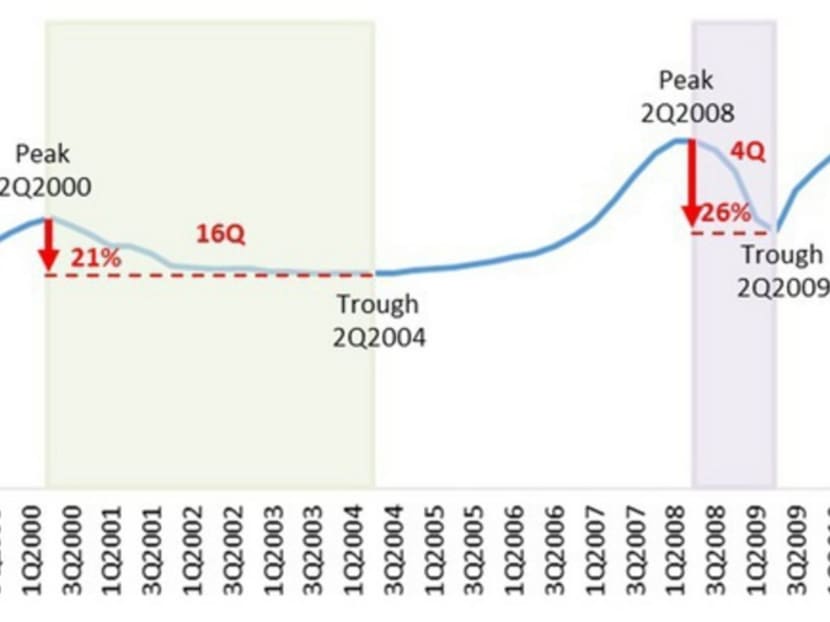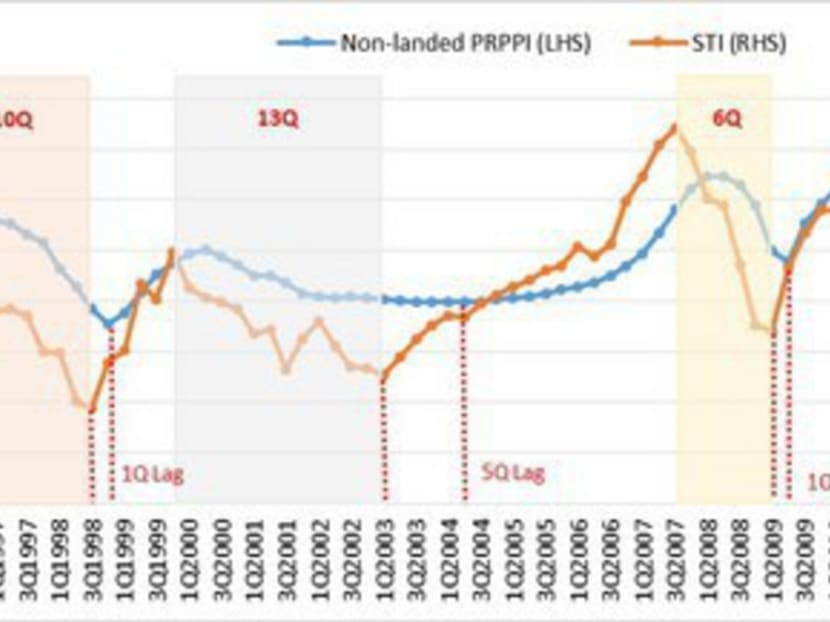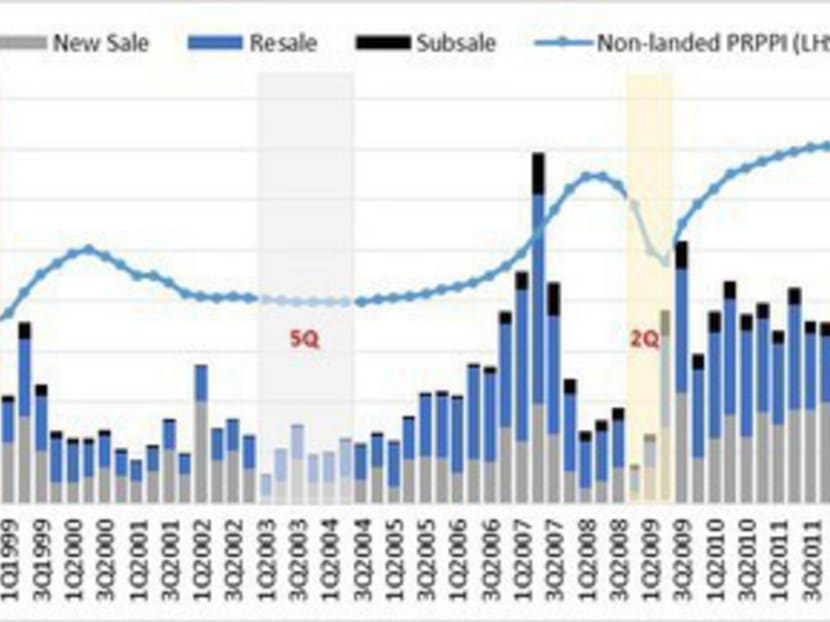How long will the residential property downcycle last?
Over the past 20 years, Singapore’s private residential property market has gone through three downcycles and it is in the midst of a fourth. The Urban Redevelopment Authority’s flash estimate for the third quarter published earlier this month showed prices have fallen for eight straight quarters. Once the detailed statistics are released later this month, the non-landed Private Residential Property Price Index (PRPPI) is expected to follow suit. The PRPPI fell 42 per cent from peak to trough in the first downturn, 21 per cent in the second and 26 per cent in the third (see Chart 1).



Over the past 20 years, Singapore’s private residential property market has gone through three downcycles and it is in the midst of a fourth. The Urban Redevelopment Authority’s flash estimate for the third quarter published earlier this month showed prices have fallen for eight straight quarters. Once the detailed statistics are released later this month, the non-landed Private Residential Property Price Index (PRPPI) is expected to follow suit. The PRPPI fell 42 per cent from peak to trough in the first downturn, 21 per cent in the second and 26 per cent in the third (see Chart 1).
WILL PRICES FALL 30 PER CENT IN THREE YEARS, OR BY 2040?
In October 2014, Barclays Bank forecast that property prices in Singapore will fall by 20 per cent this year. Other analysts have forecast a 20 per cent to 30 per cent decline in prices in the next few years. The National University of Singapore’s Institute of Real Estate Studies forecast that home prices could fall 30 per cent by 2040 due to an ageing population.
While the forecasts and timeframes vary widely, it would appear that the consensus view is that the PRPPI will continue to decline in the foreseeable future. While forecasts of big drops make good headlines for the press and research reports, such projections are something that even seasoned statisticians with complex mathematical models will struggle with. Perhaps a more meaningful exercise for potential investors is looking for the leading indicators that point to a trough in the market rather than trying to estimate the magnitude of price falls.
HOW LONG DID PAST DOWNCYCLES LAST?
Based on historical trends, the downcycle lasted 10 quarters after the Asian financial crisis, 16 quarters during the post-SARS period and surprisingly just four quarters following the Global Financial Crisis. Presently, the PRPPI has contracted for seven consecutive quarters (see Chart 1).
Thus, we could either be near the bottom of the cycle or just halfway through. The overall eco-system of factors that affect wealth creation and destruction likely holds the answer. These include indicators such as stock-market performance, the unemployment rate, the number of bankruptcies, changes in prime lending rates, home occupancy rates, the number of rental contracts and unsold inventory.
This article looks at the relationship between the PRPPI and the performance of the stock market, as indicated by the Straits Times Index (STI), as well as the relationship between the PRPPI and the total number of housing transactions.
DECLINE OF the STOCK MARKET CAN LEAD TO FURTHER DECLINES IN PRPPI
The performance of the financial markets can provide a good indicator of a wealth creation or destruction cycle. Analysing the quarter-on-quarter changes in the STI and the PRPPI, we note that the PRPPI tends to reach a bottom between one and five quarters after the STI hits the trough (see Chart 2). It can be inferred that when the stock market falters, in general, companies are not profitable and/or business prospects look poor. Investors in the stock market may also be losing wealth.
The destruction of wealth creates the preconditions for people to sell their properties quickly and with sharper discounts. Thus, based on historical trends, the property market appears unlikely to reach a bottom before the stock market hits a trough.
While the STI has faltered recently in the wake of China’s economic slowdown, most analysts are of the opinion that the stock market has not yet reached a trough.
CONSISTENT DECLINE OF TRANSACTION VOLUME LEADS TO PRPPI REACHING A TROUGH
In past cycles, whenever the total number of housing transactions reaches a trough, the PRPPI tends to reach a bottom between two and five quarters thereafter (see Chart 3). However, predicting when transaction volume has reached a bottom might prove more challenging. Generally, the trough of transaction volume is preceded by two to three quarters of below-average transaction volume, but this relationship is weak.
REMOVING ABSD A NECESSARY BUT INSUFFICIENT CONDITION FOR SUSTAINED RECOVERY
Taking the above indicators into consideration (and others that were not shared in this article), we can conclude that the PRPPI is still some way off from reaching a trough. Many market participants are clamouring for the removal of the Additional Buyer’s Stamp Duty (ABSD) as a catalyst to revive the market. Scrapping the ABSD could provide a short-term boost to transaction activity and even provide a small uptick in prices. However, removing the ABSD is a necessary but insufficient condition for a sustained upswing in market activity when the fundamental drivers of housing demand remain weak.
While investors are understandably cautious in this uncertain environment, there are still buyers looking to purchase for owner-occupation. There are also others who are currently renting apartments who may be contemplating ownership to take advantage of the low interest rate environment and decreasing prices. These potential buyers should look for homes in areas where property prices have fared relatively better during downcycles, where there are fewer units under construction and where there are structural changes in the infrastructure as well as Government initiatives that could make the location more attractive.
ABOUT THE AUTHOR: Tan Kok Keong is Chief Executive of property consultancy REMS Advisors and Co-founder of alternative investment platform Fundplaces.





